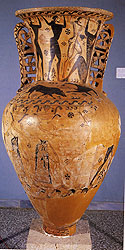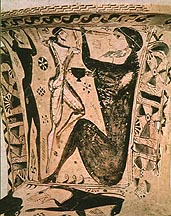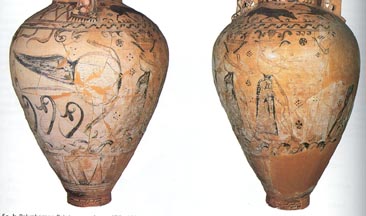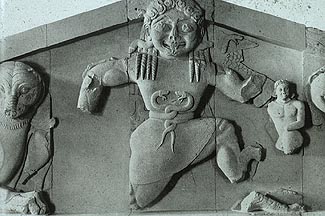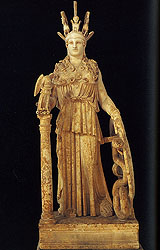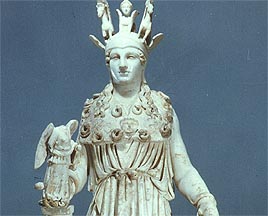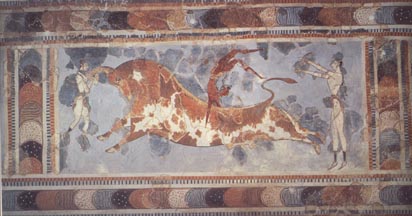Art Home | ARTH Courses | ARTH 200 Assignments
Greeks and the Other
Art played a central role in defining identity in Greek culture. Representations of the actions of heroes presented models of what a Greek should be. At the same time art was a vehicle to express what is non-Greek. While the Greek city-states fiercely held onto their own independence, there was still an important sense of what it was to be Greek. Greeks were unified by a common language, culture, and religion. As Greeks came into contact with other cultures, they emphasized the difference between themselves and others. It is in Greek culture that the concept of the "barbarian" was invented. "Barbarian" ultimately is a Greek word. It was used by the Greek to identify a non-Greek speaker, one who speaks nonsense or "bar bar".
The vase above known as the Eleusis Amphora comes from the beginning of the seventh century BCE. Scholars identify the period it comes from as the Orientalizing period. This is a period of dramatic change in Greek art as Greek culture expands out and comes under the influence of non-Greek, especially Near Eastern cultures. A major theme in the art of this period is the contrast between the Greek and the Other. The Eleusis Amphora is a good example of this. On the neck and belly of the vase which was used as a grave marker appear two Greek legends.
On the neck appears the story of Odysseus blinding the cyclops Polyphemus. This representation can be related to an episode in the Homeric epic The Odyssey, which recounts the adventures on his return home from the Trojan War. The Odyssey with its tales of fabulous lands and peoples was clearly written to capture the encounter of the Greek with the non-Greek. As emphasized in Homer's account of the encounter with Polyphemus, the cyclops was considered to be monstrous by his large size and single eye. He also lived in a cave in a wild land. Homer's account clearly reflects the Greek colonizer assessing the land to see how it could be transformed into a civilized, cultivated Greek settlement.
What is shown in the vase is the culminating moment in encounter with Polyphemus. The cyclops had trapped Odysseus and his followers. They were emprisoned in his cave, and Polyphemus had begun to eat them one at a time. To escape Odysseus was able to get Polyphemus drunk and then took a burning brand and blind Polyphemus. Note how the artist has emphasized the drunkenness of Polyphemus by including the drinking cup and articulated his wildness by showing the grimace of his face. This is in marked contrast to Odysseus who uses his cunning or what the Greeks called arete to defeat the cyclops.
The scene shown on the belly of the amphora is a representation of the story of the hero Perseus fleeing the Gorgons after he had beheaded Medusa (contrast the conception of Medusa articulated on this page to the excerpt from Bullfinch's Mythology). Accompanying Perseus is the goddess Athena who helped Perseus by giving him the mirror so that he would not look directly at Medusa and be turned into stone. The story of Perseus and Medusa was one of the most popular stories in Greek art from the Orientalizing period of the seventh century BCE through the Archaic period lasting to the beginning of the fifth century BCE. The wild, grimacing face of Medusa with snakes in her hair was one of the most favorite monsters to be represented in Greek culture. The example that follows comes from the sculpture of the pediment of a middle of the sixth century temple at Corfu:
As a female monster with snakes Medusa was one of the most typical examples of the Other in Greek culture. She epitomized the monstrous as being female and wild. The demonization of snakes here is particularly interesting. Comparison can be made between these images of Medusa and representations of the so-called Snake Goddess that come from Minoan art of the middle of the second millenium BCE:
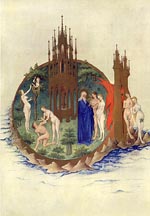 We
do not know whether this figure represents a goddess or not, but consider
the
comparison
between this and the Medusa figures. She holds snakes in her hands and has
a cat on her head. Think about the symbolism of these in western culture.
You should also consider the Adam and Eve story from Genesis [the
example I show here is from an early fifteenth century French manuscript:
the Très
riches heures].
The Halle Barry character in Catwoman can be seen as an updated
version of the Snake Goddess. For
more discussion on the Snake Goddess and the story of Medusa see the webpage
entitled Principal
Greek and Roman Gods and Goddesses and pages linked from this page.
Also see the webpage dedicated to the topic by Chris
Witcombe. Chris Witcombe also dedicates a page to Eve
and the Identity of Women. In considering the Snake Goddess it is interesting
to speculate about the position
of women
in Minoan
society.
We
do not know whether this figure represents a goddess or not, but consider
the
comparison
between this and the Medusa figures. She holds snakes in her hands and has
a cat on her head. Think about the symbolism of these in western culture.
You should also consider the Adam and Eve story from Genesis [the
example I show here is from an early fifteenth century French manuscript:
the Très
riches heures].
The Halle Barry character in Catwoman can be seen as an updated
version of the Snake Goddess. For
more discussion on the Snake Goddess and the story of Medusa see the webpage
entitled Principal
Greek and Roman Gods and Goddesses and pages linked from this page.
Also see the webpage dedicated to the topic by Chris
Witcombe. Chris Witcombe also dedicates a page to Eve
and the Identity of Women. In considering the Snake Goddess it is interesting
to speculate about the position
of women
in Minoan
society.
| Copies of the chryselephantine statue of Athena Parthenos made for the cella of the Parthenon, 447-432 B.C. At the center of her "aegis" or breast plate appears the head of Medusa which had been given to Athena by Perseus in thanks for her aid in defeating Medusa. The head of the Medusa along with the sphinx and griffins depicted on the helmet demonstrate how Athena has brought the monstrous into order and appropriated its power. | |
Another
major work associated with Minoan art is a fresco from the palace of Knossos
on Crete. It was painted about 1450 BCE, and scholars have speculated about
the nature of the practice shown here. It anticipates the important role
the bull will play in western culture down to Bullfighting in Spain. 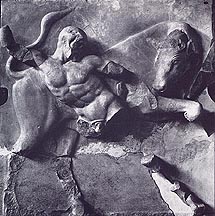 What
is interesting is the different relationship of the humans
to the bull in the Minoan image from what is found in later art. Consider
here the relief sculpture from the Temple of Zeus at Olympia coming from
the middle of the fifth century BCE.
What
is interesting is the different relationship of the humans
to the bull in the Minoan image from what is found in later art. Consider
here the relief sculpture from the Temple of Zeus at Olympia coming from
the middle of the fifth century BCE. 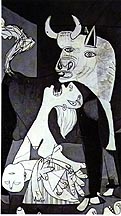 The
relief is part of a series of panels that represent the Labors of Heracles.
This particular one illustrates
Heracles defeating the Cretan Bull. In this context it is important to
remember the myth of King
Minos and the Minotaur. As an example of the continuity of the imagery
of the Minotaur in western art consider the illustrations included in the
article by Martin Ries entitled Picasso
and the Myth of the Minotaur. At the end of the semester we will be
considering Picasso's Guernica which
includes an image of the bull.
The
relief is part of a series of panels that represent the Labors of Heracles.
This particular one illustrates
Heracles defeating the Cretan Bull. In this context it is important to
remember the myth of King
Minos and the Minotaur. As an example of the continuity of the imagery
of the Minotaur in western art consider the illustrations included in the
article by Martin Ries entitled Picasso
and the Myth of the Minotaur. At the end of the semester we will be
considering Picasso's Guernica which
includes an image of the bull.
What we see in works focusing on the theme of the Greek versus the non-Greek is the clear articulation of a system of binaries that articulate what it is to be a Greek as exemplified by the heroes and what is non-Greek or barbaric:
|
Greek
|
Non-
Greek (Barbarian)
|
|
Male
|
Female
|
|
Civilized
|
un-Civilized (wild)
|
|
Order
(cosmos)
|
chaos
|
|
Rational
|
Irrational
|
|
Human
|
Animal
|
This contrast has played an important role in western political discourse inherited from the Greeks. Note how the idea of the Barbarian has been used in western culture to characterize the non-Western, or the Other. As a dramatic example of the continuity of this tradition of discourse, consider the following excerpt from President Bush's speech before the General Assembly in September of 2003:
|
Events during the past two years have set before us the clearest of divides: between those who seek order, and those who spread chaos; between those who work for peaceful change, and those who adopt the methods of gangsters; between those who honor the rights of man, and those who deliberately take the lives of men and women and children without mercy or shame.
|
Remember also the excerpt from Lord Clark's Civilisation quoted in the first webpage:
| I don't think there is any doubt that the Apollo embodies a higher state of civilisation than the mask. They both represent spirits, messengers from another world --that is to say, from a world of our own imagining. To the Negro imagination it is a world of fear and darkness, ready to inflict horrible punishment for the smallest infringement of a taboo. To the Hellenistic imagination it is a world of light and confidence, in which the gods are like ourselves, only more beautiful, and descend to earth in order to teach men reason and the laws of harmony. |
